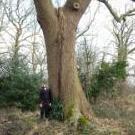we covered this in college......
Hedges and trees - Anti-social Behaviour Act 2003 Part 8
All trees and hedges, but especially Leyland are notorious for growing fast and becoming “out-of-control”.
In June 2005, new legislation was created to deal with problematic hedges, especially complaints from residential neighbours. Please note that the situation in Wales is different England.
Part 8 of the Anti-social Behaviour Act 2003 has created new procedures to enable local authorities to deal with such complaints about high hedges.
The ideal would be for the dispute between the neighbours to be resolved without timely, costly intervention; however, once the situation has been questioned by the complainant, and no action has been taken, the complainant can make an official complain to the local authority.
What will it cost?
To make a complaint, the local council will charge a fee between £100 and £600. The amount is set by the council and therefore varies from shire to shire. If you are receiving benefits you may be eligible for a discount. Unfortunately, there is no way at this stage, to claim the fee back from the hedge-owner, however, Net Lawman will keep you informed if this changes.
Which Hedges Count?
* Hedge disputes must have been discussed between the relevant parties prior to a complaint. If the height of the hedge has not been complained about first, the initial complaint to the council will be rejected;
* You may take the dispute to the local authority if;
* The hedge compromises wholly, or predominantly a line of two or more evergreen or semi-evergreen trees or shrubs;
* It is over 2m high;
* The hedge acts in someway as a barrier to light or access;
* Because of its height, the hedge adversely affects the complainant’s reasonable enjoyment of their domestic property.
How does the local authority deal with the complaint?
The local authority will charge a fee, as mentioned earlier. The legislation does not specify how the council should deal with the complaint; however, they should of course take into account all relevant factors and assess each.
They will normally send an employee to come round and check the hedge to measure its height and gather other information. They might attempt to talk to the owner and complainant and its contribution to the area it resides in. The council alone make the decision whether the hedge is causing adverse affects to the complainant. They then decide what remedy should be taken to overcome the problem. They may decide that no action is necessary.
Remedies
If action is to be taken, the council will issue a ‘remedial notice’. This is a formal notice to the person responsible for the hedge. Examples of remedies include long-term maintenance of the hedge at a lower height.
Appeals
Both the hedge owner and the complainant can appeal against the decision of the authorities. They have 28 days in which to do so. The notice will usually be suspended whilst the appeal is in process.
Enforcement
It is an offence not to comply with a remedial notice. The person could be charged up to £1000 and / or a second notice may be issued. This is usually to quicken the speed of remedy and a time period might be set for the resolution of the problematic hedge. The magistrate’s court is also able to set a daily fine for every day that the work continues to be outstanding.
Where the issue is not resolved, the council have the authority to remedy the hedge and recover the cost from the hedge owner.






